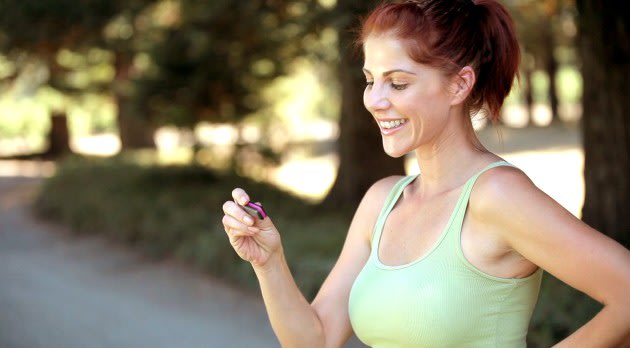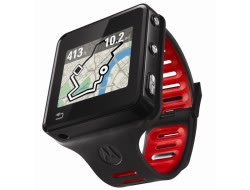 (Photo courtesy Fitbit)
(Photo courtesy Fitbit)
Ah, Memorial Day Weekend. The sun's out, the pools are open, and you've probably already switched out your long sleeves and jeans for something a little more summery.
Hopefully, the hot-weather duds still fit, because the colder months takes a serious toll on our waistbands. Motivating to shed those pounds is tough, though -- especially if, like us, you're more prone to ogling an iPhone than swinging a kettlebell. Luckily, it's easier than ever to stay on track while trying to shape up, thanks in no small part to high-tech fitness tools like these.
==Gadgets==
 Fed up with holding your cellphone while you work out? Here's the solution.
Fed up with holding your cellphone while you work out? Here's the solution.
Sleek, black, and sporting an attractive square touchscreen, this new offering from Motorola packs a GPS tracker, MP3 player, and general-purpose pedometer and activity monitor into a watch-sized form factor that's seriously unobtrusive. Its logical interface, clear screen, and strong online tools make it a joy to use, and if you wear it all day it'll count your steps and estimate your caloric burn from your everyday activities. It'll even sync with its website over your wireless network, no computer needed.
All that functionality takes its toll on the watch's battery life, and it works better with Android devices than iPhones, but as an all-in-one fitness tracker and music player, it's top notch. At around $250 for the basic 8 GB model, it doesn't seem cheap -- but stack that up next to the cost of replacing an on-contract iPhone after dropping one in a muddy puddle mid-run, and it's suddenly better value.
 If you're looking for a set-it-and-forget-it solution, the Fitbit is more your style. It's an unobtrusive black object that clips to your clothing, recording your movements over the course of a day while tracking your sleep patterns at night. The newest version can even tell how many flights of stairs you've climbed and syncs automatically when it's in range of its base station.
If you're looking for a set-it-and-forget-it solution, the Fitbit is more your style. It's an unobtrusive black object that clips to your clothing, recording your movements over the course of a day while tracking your sleep patterns at night. The newest version can even tell how many flights of stairs you've climbed and syncs automatically when it's in range of its base station.
Its accompanying web site puts all that information in one handy location, and will even feed your calorie total into fitness tracking sites like MyFitnessPal. At under $100, it's a great way to get a handle on your daily energy needs, and it really couldn't be any simpler to use.
 But the Fitbit is really only useful for walking, running, and other on-foot daily activities. What if you want to track workouts on exercise equipment, weight sessions, or biking?
But the Fitbit is really only useful for walking, running, and other on-foot daily activities. What if you want to track workouts on exercise equipment, weight sessions, or biking?
Enter the high-tech Bodymedia Link, an armband that tracks your body's calorie burn rate regardless of whether you're running a marathon or doing the dishes, recording 5,000 data points per minute and combining them to give you an (allegedly) accurate picture of exactly how hard you're working, all day, every day. One clinical trial demonstrated armband-using dieters lost three times as much weight as a control group did.
Sure, the idea is appealing -- and the hardware indeed works beautifully -- but it's not the sleekest of devices. Depending on your wardrobe you may find yourself fielding some curious questions from friends and coworkers. It's also not as well integrated with other tools and websites as the Fitbit, and at $99 for the basic armband and $6.95 per month in subscription fees, it ain't cheap. If you're serious about improving your health, though, we think it's worth the price.
==Apps==
Having a hard time jumpstarting your jogging regimen? Maybe you just need some brainy motivation.
Here's an innovative app that puts a pack of (simulated, we hope) zombies on your tail, mixing the groans and moans of the shambling undead into your own choice of music, and unveiling its post-apocalyptic storyline as you stack up the miles. Run well, and you'll find ammo and medicine to distribute to fellow survivors; run poorly, and the only thing you'll be distributing is your delicious brain. To the zombies. It's currently iOS-only, but Android users can join in the fun in mid-June.
Couch to 5K
Responsible for propelling countless thousands of sedentary spuds from running novices to road-racing superstars, the Couch-to-5K program is easily the most famous beginner training programs in the running world.
Easing you from walker to runner via a two-month series of carefully-designed running and walking workouts, the only hard thing about it is keeping track where you are in the program, and exactly what you're supposed to be doing today. Fortunately, a slew of purpose-built apps are out there to do the bookkeeping for you; our favorite is Bluefin Software's Ease into 5K, which costs just a few bucks on iOS or Android.
==Websites==
Gym fees? No thanks. Expensive equipment? No room. If you want to drop some pounds, one of the cheapest ways to burn off some calories is just to get out and run (or walk, if you prefer). Tracking time, distance and caloric burn is key to staying focused, and one great way to do that is with a site like Runkeeper.
Runkeeper -- and a slew of competing, similar web sites -- use your smartphone's GPS to record your route, and then uploads it to a online page where you (and your friends, if you like) can marvel at your get-up-and-go spirit. Contrary to what its name may imply, it can also track cycling workouts and has limited ability to record cardio sessions at the gym. It's just one of many -- Endomondo, Strava, and MapMyRun are three of its biggest competitors -- but they're all free. Try them all, and see which has the interface and mobile app that suits you best.
That's all very well for runners and cyclists, but how do you log your sessions in the weight room?
Enter Fitocracy, a comparatively new player in the fitness tracker market created by a motley crew of fitness nerds, gamers, and assorted geeks. It's by far the most outwardly "gamey" of the tracker web sites, assigning you points for every activity you complete, handing out achievements, level-ups, and quest-like workout goals, then showing you how your progress matches up to your friends.
Maintaining motivation can be one of the biggest challenges in making a new health regimen stick -- perhaps Fitocracy's approach has what it takes to get your competitive side into the game.
If job one in undertaking a weight loss program is getting clearance from your physician, job two is understanding your food intake. Web site and mobile app MyFitnessPal is built for just this purpose, and it'll do it in exhaustive detail. With a vast database of foods (generic, restaurant, and packaged) if you put in the effort to keep it current it'll reward you with detailed breakdowns of not only your calorie intake, but also your daily consumption of protein, carbs, fat, salt, sugar, vitamins and minerals.
Don't underestimate the grunt-work involved in doing this, but MyFitnessPal's slick mobile app makes it about as hassle-free as it can be -- it'll even use your phone's camera to recognize a product's barcode and automatically pull up its nutritional info. Other, arguably prettier alternatives exist (notably Lance Armstrong's Livestrong.com) but we found MyFitnessPal to be the most streamlined.
For some, working out is its own reward. For the rest of us, we need a little more incentive. Earndit promises just that: it's not a fitness tracker itself, but it'll suck down data from a number of other sites, aggregating it and assigning you points based on your activity level. Rack up enough points, and you can spend them on a slew of rewards: everything from clothing gift cards to dietary supplements. You can even give them to charity. If you're out there putting in the miles, why not?
No comments:
Post a Comment